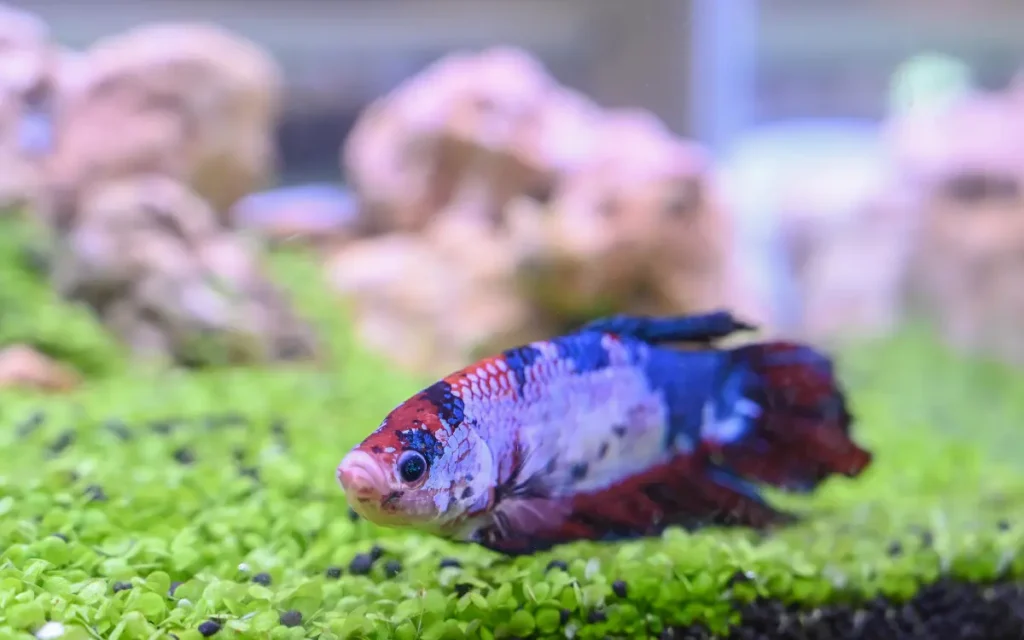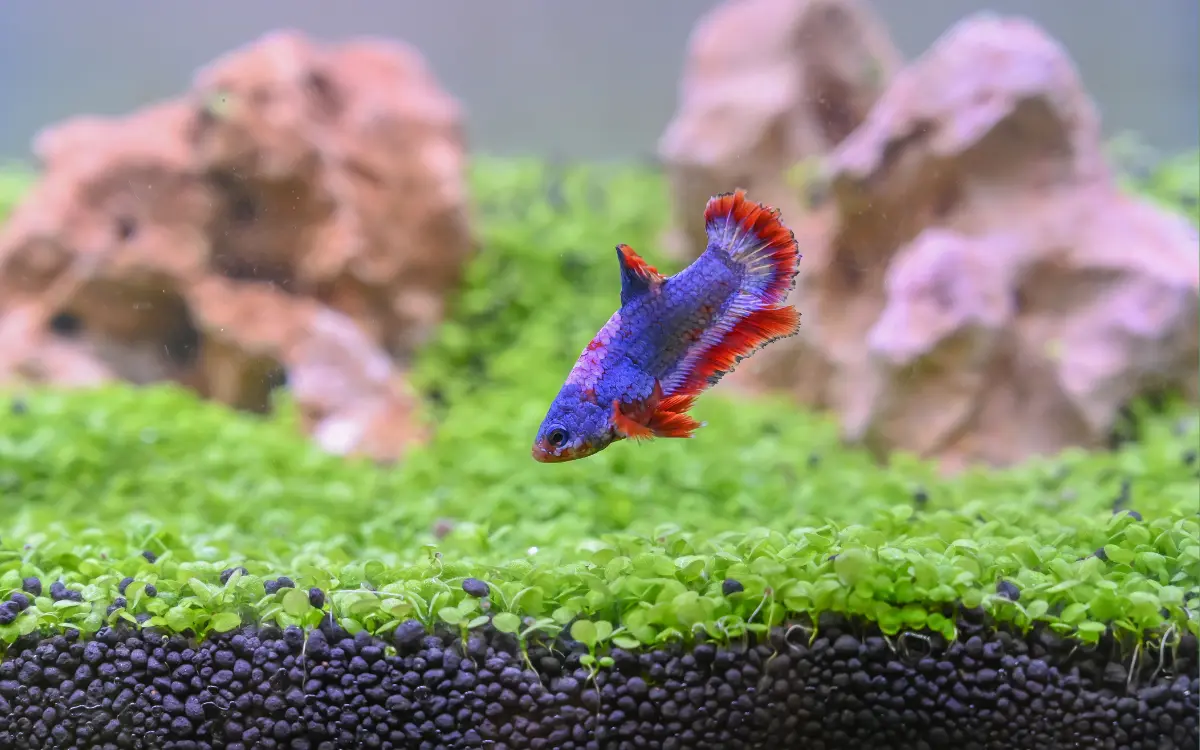Keeping the right pH level is vital for your Betta fish’s health and well-being. It helps keep your Betta comfortable, stress-free, and thriving.
In this guide, we’ll explore what pH levels are best for Bettas, why they matter, and how to maintain them effortlessly.
Ideal pH Range
The recommended pH level for Betta fish is between 6.5 and 7.5. This slightly acidic to neutral range closely resembles their natural habitat, keeping them healthy and stress-free.
Staying within this range helps support their immune system, digestion, and overall comfort. pH levels outside this range can lead to stress, illness, and even fatal health issues.
Regularly testing and adjusting the pH ensures that your Betta’s water remains stable and suitable, promoting a happy, long life for your fish.
Testing pH Levels
To keep your Betta fish healthy, it’s essential to monitor pH levels regularly. There are two main tools you can use: aquarium test kits and digital pH meters. Aquarium test kits are simple, affordable, and typically come with color-coded strips that let you compare results to a chart.
Digital pH meters, while slightly more expensive, provide highly accurate readings and are easy to use.
Testing the pH at least once a week is recommended, especially during water changes or when introducing new elements like plants or decorations.
For consistency, try to test the water around the same time each day, as pH can vary due to factors like lighting or temperature.
To ensure accuracy, rinse the testing equipment with distilled water after each use and follow the instructions carefully. Consistent monitoring helps you detect any sudden pH shifts that could affect your Betta’s health.
Factors Affecting pH in Betta Tanks

Several common factors can cause pH fluctuations in your Betta tank, potentially impacting your fish’s health.
First, substrates such as gravel, sand, or specific stones can alter pH. Some substrates, like crushed coral, increase pH, while others, like certain types of driftwood, can make the water more acidic.
Decorations can also have an effect—natural items like rocks, seashells, and even plants can slowly change pH levels over time.
Tap water is another factor; it often contains minerals that affect pH depending on your local water supply. Always test your tap water before adding it to the tank and, if necessary, use water conditioners or additives to adjust the pH to an ideal range for Bettas.
Additionally, the ammonia and biological load in your tank play significant roles. Ammonia, produced by fish waste and decaying food, can lower the pH as it accumulates.
This is because bacteria in the tank break down ammonia into nitrites and nitrates, releasing acidic compounds into the water.
Regular water changes, a well-functioning filter, and not overstocking the tank help manage these levels, maintaining stable pH for your Betta. Proper maintenance will prevent drastic pH changes and keep your Betta’s environment safe and healthy.
How to Adjust pH Levels Safely
Adjusting the pH in your Betta tank should be done gradually to avoid stressing or shocking your fish. Here are some safe methods for adjusting pH levels:
To lower the pH, natural options like driftwood or Indian almond leaves work well. Driftwood releases tannins, which gently lower pH and provide a more natural environment for Bettas.
Indian almond leaves also release tannins, creating a slightly acidic, Betta-friendly environment while adding beneficial antioxidants. Additionally, you can use pH-reducing products specifically made for aquariums, following the instructions carefully.
To increase the pH, consider adding crushed coral to your tank, either directly in the substrate or inside the filter. Crushed coral releases calcium carbonate, which raises the pH over time.
You can also use pH booster products available at aquarium stores for quicker adjustments. Just be sure to read the directions thoroughly, as overuse can cause the pH to spike too rapidly.
Making adjustments gradually is key. Sudden shifts can shock your Betta, leading to stress and potential health issues.
Aim to make small changes over several days, testing the water each time you add something new. By slowly adjusting pH levels, you create a safe, stable environment where your Betta can thrive comfortably.
pH Stability Tips
Maintaining stable pH levels in your Betta tank is essential for their health. Here are some tips to help keep the pH consistent:
Regular Water Changes: Performing partial water changes (about 20-25%) every week helps keep the water clean and the pH steady. Use dechlorinated water at a similar pH to the tank to avoid sudden changes.
Stable Decorations and Substrate: Choose aquarium-safe decorations and a neutral substrate that won’t alter the pH over time. Avoid shells or limestone, which can increase pH, unless you specifically need a higher pH level.
Monitor Water Quality: Regularly check water parameters, including ammonia, nitrites, and nitrates. High biological load can lead to pH drops, so a well-functioning filter and not overfeeding will help manage waste buildup.
Common pH Problems and Solutions
If the pH in your Betta tank is too high or low, your fish may show signs of distress, including lethargy, loss of color, clamped fins, and general signs of stress. Here’s how to identify and correct pH issues safely and effectively:
Test the pH: If your Betta exhibits symptoms of stress, start by testing the water’s pH level. Compare it to the ideal range of 6.5 to 7.5. If it’s outside this range, it’s time to make adjustments.
Lowering pH: If the pH is too high, add natural items like driftwood or Indian almond leaves to gradually lower it. For quicker adjustments, use a pH-reducing solution following the instructions carefully. Always change the pH slowly, testing the water between each adjustment.
Raising pH: If the pH is too low, you can add crushed coral or use a pH-increasing product designed for aquariums. These materials release minerals into the water, gently raising the pH over time.
Monitor and Adjust Slowly: Correct pH gradually, making small changes daily to avoid shocking your Betta. Test the pH after each change to ensure you’re moving toward the ideal range.
By regularly monitoring pH and taking corrective actions as needed, you’ll maintain a balanced, healthy environment for your Betta, allowing them to thrive without stress.
Conclusion
Maintaining the correct pH levels is essential for your Betta fish’s health and overall well-being. Regular monitoring and adjustments help keep their environment stable and stress-free, allowing them to thrive. With consistent care, you’ll provide a comfortable home where your Betta can live happily and healthily.

